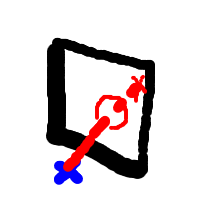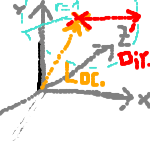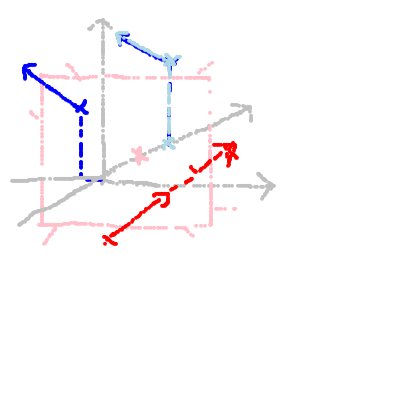 We need the program to render edges intersecting the projection plane.
We need the program to render edges intersecting the projection plane. We need the program to render edges intersecting the projection plane.
We need the program to render edges intersecting the projection plane.
Here, in the first image, you see an edge that goes right through the screen.
The edge is defined by two Points, one before and one behind the screen plane.
For the mathematical task of calculating the intersection of edges with the screen plane (or any plane at all), we use the concept of "rays"
In the image, you can see two Points in 3d-space connected by a line.
But remember: A ray is specfied as a directed line in the 3d-space with infinite length, though - not limited by one of the points.
Any 3d-ray can be represented mathematically as 2 3d-vectors: One specifying a start location in 3d space and the other specifying the direction of the ray from that point.
Any Point p ∈ Ray is composed of VLocation + x * VDirection

Here the example of a basic vector representation: The direction vector is normalized and thus always points onto the edge of a sphere of radius 1 around the point that the Location part of the ray specifies.
Now we try to calculate where the ray intersects a specific plane, for example z=0 or z=1
The base planes z=0 and z=1 are the two relevant planes for most simple z-Projection. Why? z=0 because it's the most intuitive. And z=1 for any projection after we have constated that a division "by (z+1)" instead of "by z" must be done in order to perform a projection - which lets us respect that a point on the z-plane (like (1,0,0), (0,1,0) could not be projected before since a division by 0 occured!
There are three cases:

Graphical Illustration of the 3 cases with a pink screen plane defined by z=1. Case 1 is blue, Case 2 lightblue. Case 3 is red.
Continue here: Let's Continue 3d VII - Trying to set up a 3d context
Or jump directly to VIII: Ray Intersection Continued